Effects of Kuroshio and Mesoscale Eddy on Fishing Ground Gravity of Neon Flying Squid Ommastrephes bartramii in Northwest Pacific Ocean
Abstract
1. Introduction
2. Materials and Methods
2.1. Study Area
2.2. Fishing Effort of the Jigging Fishery
2.3. Environmental Data
2.4. Mesoscale Eddy
2.5. Eddy Kinetic Energy
2.6. Gravity of Fishing Effort
2.7. Pearson Correlation Coefficient
3. Results
3.1. Distribution of Monthly Fishing Effort and Environment Factors
3.2. Fishing Effort and Environmental Factors
3.3. Variations in the Distribution Centroid of the Squid Fishing Ground
3.4. El Niño and La Niña Events
3.5. Relation between Kuroshio Indicators and the Number of Mesoscale Eddies
4. Discussion
4.1. Influence of El Niño/La Niña Events on the Distribution of Fishing Grounds
4.2. Impact of the Kuroshio on the Distribution of Fishing Grounds
Supplementary Materials
Author Contributions
Funding
Institutional Review Board Statement
Informed Consent Statement
Data Availability Statement
Conflicts of Interest
References
- Jereb, P.; Roper, C.F.E. Cephalopods of the world. An annotated and illustrated catalogue of cephalopod species known to date. In Myopsid and Oegopsid Squids; Food And Agriculture Organization Of The United Nations: Rome, Italy, 2010; Volume 2, p. 605. [Google Scholar]
- Bower, J.R.; Ichii, T. The red flying squid (Ommastrephes bartramii): A review of recent research and the fishery in Japan. Fish. Res. 2005, 76, 39–55. [Google Scholar] [CrossRef]
- Wang, J.; Cheng, Y.; Lu, H.; Chen, X.; Lin, L.; Zhang, J. Water Temperature at Different Depths Affects the Distribution of Neon Flying Squid (Ommastrephes bartramii) in the Northwest Pacific Ocean. Front. Mar. Sci. 2022, 8, 741620. [Google Scholar] [CrossRef]
- Chen, X.J.; Zhao, X.H.; Chen, Y. Influence of El Niño/La Niña on the western winter–spring cohort of neon flying squid (Ommastrephes bartramii) in the northwestern Pacific Ocean. ICES J. Mar. Sci. 2007, 64, 1152–1160. [Google Scholar] [CrossRef]
- Chen, X.; Liu, B.; Chen, Y. A review of the development of Chinese distant-water squid jigging fisheries. Fish. Res. 2008, 89, 211–221. [Google Scholar] [CrossRef]
- Zhang, Y.; Yu, W.; Chen, X.; Zhou, M.; Zhang, C. Evaluating the impacts of mesoscale eddies on abundance and distribution of neon flying squid in the Northwest Pacific Ocean. Front. Mar. Sci. 2022, 9, 862273. [Google Scholar] [CrossRef]
- Dong, E.; Shi, S.; He, J.; Tang, F. On state of squid jigging fishery and professional upgrading transformation of squid fishing vessels in the North Pacific—Take China Aquatic Products Zhoushan Marine Fisheries Co., LTD as an example. Fish. Inf. Strategy 2020, 35, 208–215. [Google Scholar] [CrossRef]
- Yatsu, A.; Midorikawa, S.; Shimada, T.; Uozumi, Y. Age and growth of the neon flying squid, Ommastrephes bartrami, in the North Pacific ocean. Fish. Res. 1997, 29, 257–270. [Google Scholar] [CrossRef]
- Watanabe, H.; Kubodera, T.; Ichii, T.; Sakai, M.; Moku, M.; Seitou, M. Diet and sexual maturation of the neon flying squid Ommastrephes bartramii during autumn and spring in the Kuroshio–Oyashio transition region. J. Mar. Biol. Assoc. United Kingd. 2008, 88, 381–389. [Google Scholar] [CrossRef]
- Alabia, I.D.; Saitoh, S.-I.; Mugo, R.; Igarashi, H.; Ishikawa, Y.; Usui, N.; Kamachi, M.; Awaji, T.; Seito, M. Seasonal potential fishing ground prediction of neon flying squid (Ommastrephes bartramii) in the western and central North Pacific. Fish. Oceanogr. 2015, 24, 190–203. [Google Scholar] [CrossRef]
- Fei, Y.; Yang, S.; Fan, W.; Shi, H.; Zhang, H.; Yuan, S. Relationship between the Spatial and Temporal Distribution of Squid-Jigging Vessels Operations and Marine Environment in the North Pacific Ocean. J. Mar. Sci. Eng. 2022, 10, 550. [Google Scholar] [CrossRef]
- Igarashi, H.; Saitoh, S.-I.; Ishikawa, Y.; Kamachi, M.; Usui, N.; Sakai, M.; Imamura, Y. Identifying potential habitat distribution of the neon flying squid (Ommastrephes bartramii) off the eastern coast of Japan in winter. Fish. Oceanogr. 2018, 27, 16–27. [Google Scholar] [CrossRef]
- Yu, W.; Chen, X. Habitat suitability response to sea-level height changes: Implications for Ommastrephid squid conservation and management. Aquac. Fish. 2021, 6, 309–320. [Google Scholar] [CrossRef]
- Chen, X.; Tian, S.; Liu, B.; Chen, Y. Modeling a habitat suitability index for the eastern fall cohort of Ommastrephes bartramii in the central North Pacific Ocean. Chin. J. Oceanol. Limnol. 2011, 29, 493–504. [Google Scholar] [CrossRef]
- Ichii, T.; Mahapatra, K.; Sakai, M.; Wakabayashi, T.; Okamura, H.; Igarashi, H.; Inagake, D.; Okada, Y. Changes in abundance of the neon flying squid Ommastrephes bartramii in relation to climate change in the central North Pacific Ocean. Mar. Ecol. Prog. Ser. 2011, 441, 151–164. [Google Scholar] [CrossRef]
- Sasai, Y.; Richards, K.J.; Ishida, A.; Sasaki, H. Effects of cyclonic mesoscale eddies on the marine ecosystem in the Kuroshio Extension region using an eddy-resolving coupled physical-biological model. Ocean Dyn. 2010, 60, 693–704. [Google Scholar] [CrossRef]
- McGillicuddy, D.J. Mechanisms of Physical-Biological-Biogeochemical Interaction at the Oceanic Mesoscale. Annu. Rev. Mar. Sci. 2016, 8, 125–159. [Google Scholar] [CrossRef]
- Mahadevan, A. Eddy effects on biogeochemistry. Nature 2014, 506, 168–169. [Google Scholar] [CrossRef]
- Ueno, H.; Bracco, A.; Barth, J.A.; Budyansky, M.V.; Hasegawa, D.; Itoh, S.; Yong Kim, S.; Ladd, C.; Lin, X.; Park, Y.-G.; et al. Review of oceanic mesoscale processes in the North Pacific: Physical and biogeochemical impacts. Prog. Oceanogr. 2023, 212, 102955. [Google Scholar] [CrossRef]
- Wang, W.; Zhou, C.; Shao, Q. An application of RS/GIS on study on the migration dynamics of Ommastrephes bartramii. High Technol. Lett. 2003, 11, 90–93. (In Chinese) [Google Scholar]
- Chen, X.; Tian, S.; Guan, W. Variations of oceanic fronts and their influence on the fishing grounds of Ommastrephes bartramii in the Northwest Pacific. Acta Oceanol. Sin. 2014, 33, 45–54. [Google Scholar] [CrossRef]
- Chen, X.; Qian, W.; Xu, L.; Tian, S. Study on Ommastrephe bartrami fishing ground and forecasting model from 150° E to 165° E in the North Pacific Ocean. Mar. Fish. Res. 2003, 24, 1–6. (In Chinese) [Google Scholar]
- Shao, Q.; Ma, W.; Chen, Z.; You, Z.; Wang, W. Relationship between Kuroshio meander pattern and Ommastrephes bartramii CPUE in northwest Pacific Ocean. Oceanol. Limnol. Sin. 2005, 36, 111–122. [Google Scholar]
- Chen, X.; Cao, J.; Chen, Y.; Liu, B.; Tian, S. Effect of the Kuroshio on the Spatial Distribution of the Red Flying Squid Ommastrephes Bartramii in the Northwest Pacific Ocean. Bull. Mar. Sci. 2012, 88, 63–71. [Google Scholar] [CrossRef]
- Talley, L.D. Distribution and Formation of North Pacific Intermediate Water. J. Phys. Oceanogr. 1993, 23, 517–537. [Google Scholar] [CrossRef]
- Mizuno, K.; White, W.B. Annual and Interannual Variability in the Kuroshio Current System. J. Phys. Oceanogr. 1983, 13, 1847–1867. [Google Scholar] [CrossRef]
- Qiu, B.; Chen, S. Variability of the Kuroshio Extension Jet, Recirculation Gyre, and Mesoscale Eddies on Decadal Time Scales. J. Phys. Oceanogr. 2005, 35, 2090–2103. [Google Scholar] [CrossRef]
- Qiu, B.; Chen, S.; Schneider, N.; Taguchi, B. A Coupled Decadal Prediction of the Dynamic State of the Kuroshio Extension System. J. Clim. 2014, 27, 1751–1764. [Google Scholar] [CrossRef]
- Nonaka, M.; Sasaki, H.; Taguchi, B.; Schneider, N. Atmospheric-Driven and Intrinsic Interannual-to-Decadal Variability in the Kuroshio Extension Jet and Eddy Activities. Front. Mar. Sci. 2020, 7, 547442. [Google Scholar] [CrossRef]
- Qiu, B.; Chen, S. Eddy-mean flow interaction in the decadally modulating Kuroshio Extension system. Deep Sea Res. Part II Top. Stud. Oceanogr. 2010, 57, 1098–1110. [Google Scholar] [CrossRef]
- Kroodsma, D.A.; Mayorga, J.; Hochberg, T.; Miller, N.A.; Boerder, K.; Ferretti, F.; Wilson, A.; Bergman, B.; White, T.D.; Block, B.A.; et al. Tracking the global footprint of fisheries. Science 2018, 359, 904–908. [Google Scholar] [CrossRef]
- Fan, J.; Chen, X.; Cao, J.; Tian, S.; Qian, W.; Liu, B. The variation of fishing ground of Ommastrephes bartramii in the Northwest Pacific concerning with Kuroshio current. J. Shanghai Ocean Univ. 2010, 19, 378–384. [Google Scholar]
- Cheng, L.; Trenberth, K.E.; Fasullo, J.; Boyer, T.; Abraham, J.; Zhu, J. Improved estimates of ocean heat content from 1960 to 2015. Sci. Adv. 2017, 3, e1601545. [Google Scholar] [CrossRef] [PubMed]
- Chelton, D.B.; Schlax, M.G.; Samelson, R.M. Global observations of nonlinear mesoscale eddies. Prog. Oceanogr. 2011, 91, 167–216. [Google Scholar] [CrossRef]
- Chelton, D.B.; Schlax, M.G.; Samelson, R.M.; de Szoeke, R.A. Global observations of large oceanic eddies. Geophys. Res. Lett. 2007, 34, L15606. [Google Scholar] [CrossRef]
- Schlax, M.G.; Chelton, D. The “Growing Method” of Eddy Identification and Tracking in Two and Three Dimensions; College of Earth, Ocean and Atmospheric Sciences, Oregon State University: Corvallis, OR, USA, 2016. [Google Scholar]
- Bessières, L.; Rio, M.H.; Dufau, C.; Boone, C.; Pujol, M.I. Ocean state indicators from MyOcean altimeter products. Ocean Sci. 2013, 9, 545–560. [Google Scholar] [CrossRef]
- Sakurai, Y.; Kiyofuji, H.; Saitoh, S.; Goto, T.; Hiyama, Y. Changes in inferred spawning areas of Todarodes pacificus (Cephalopoda: Ommastrephidae) due to changing environmental conditions. ICES J. Mar. Sci. 2000, 57, 24–30. [Google Scholar] [CrossRef]
- Tian, S.; Chen, X.; Chen, Y.; Xu, L.; Dai, X. Evaluating habitat suitability indices derived from CPUE and fishing effort data for Ommatrephes bratramii in the northwestern Pacific Ocean. Fish. Res. 2009, 95, 181–188. [Google Scholar] [CrossRef]
- Yang, H.; Qiu, B.; Chang, P.; Wu, L.; Wang, S.; Chen, Z.; Yang, Y. Decadal Variability of Eddy Characteristics and Energetics in the Kuroshio Extension: Unstable Versus Stable States. J. Geophys. Res. Ocean. 2018, 123, 6653–6669. [Google Scholar] [CrossRef]
- Sugimoto, S.; Hanawa, K. Roles of SST Anomalies on the Wintertime Turbulent Heat Fluxes in the Kuroshio–Oyashio Confluence Region: Influences of Warm Eddies Detached from the Kuroshio Extension. J. Clim. 2011, 24, 6551–6561. [Google Scholar] [CrossRef]
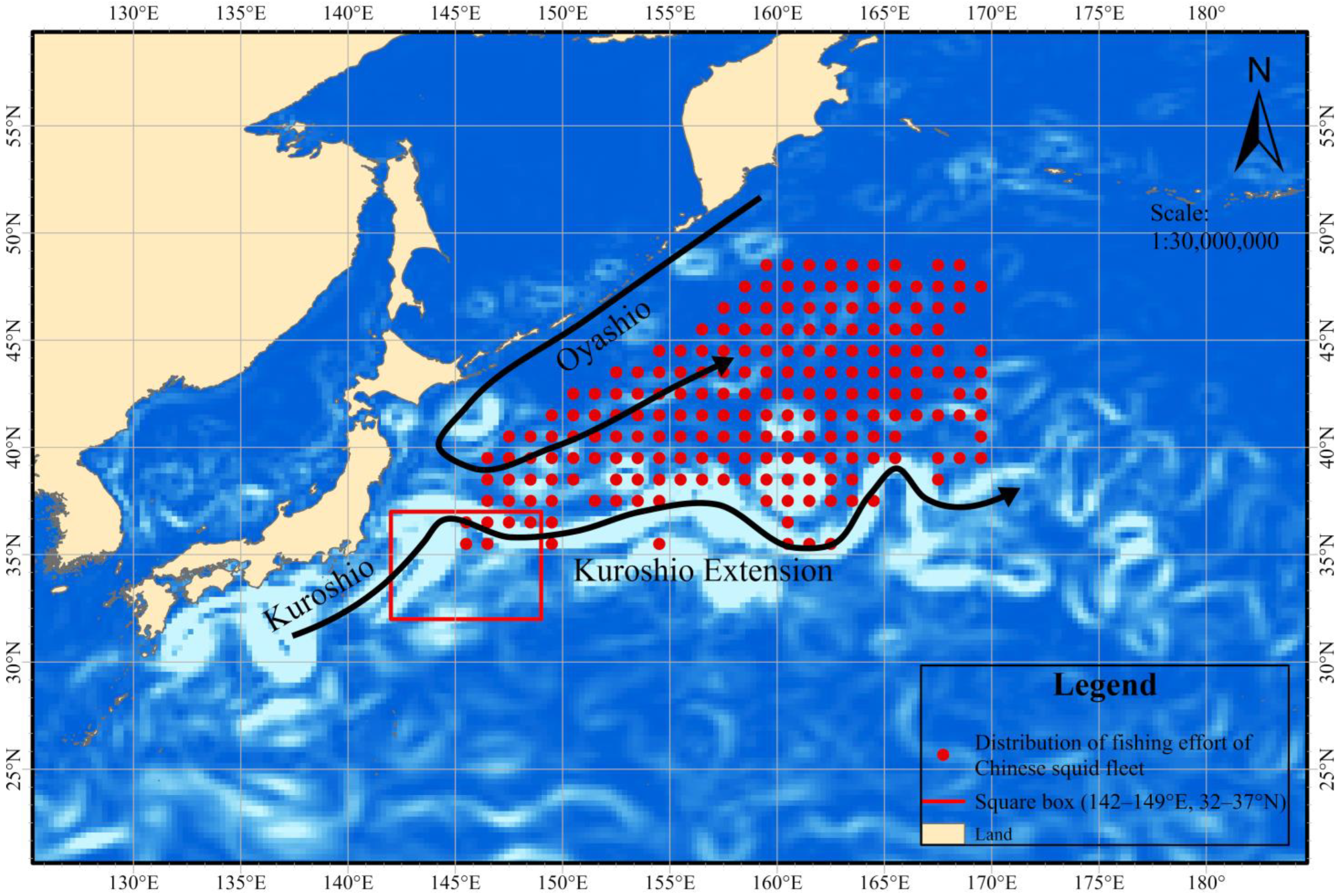
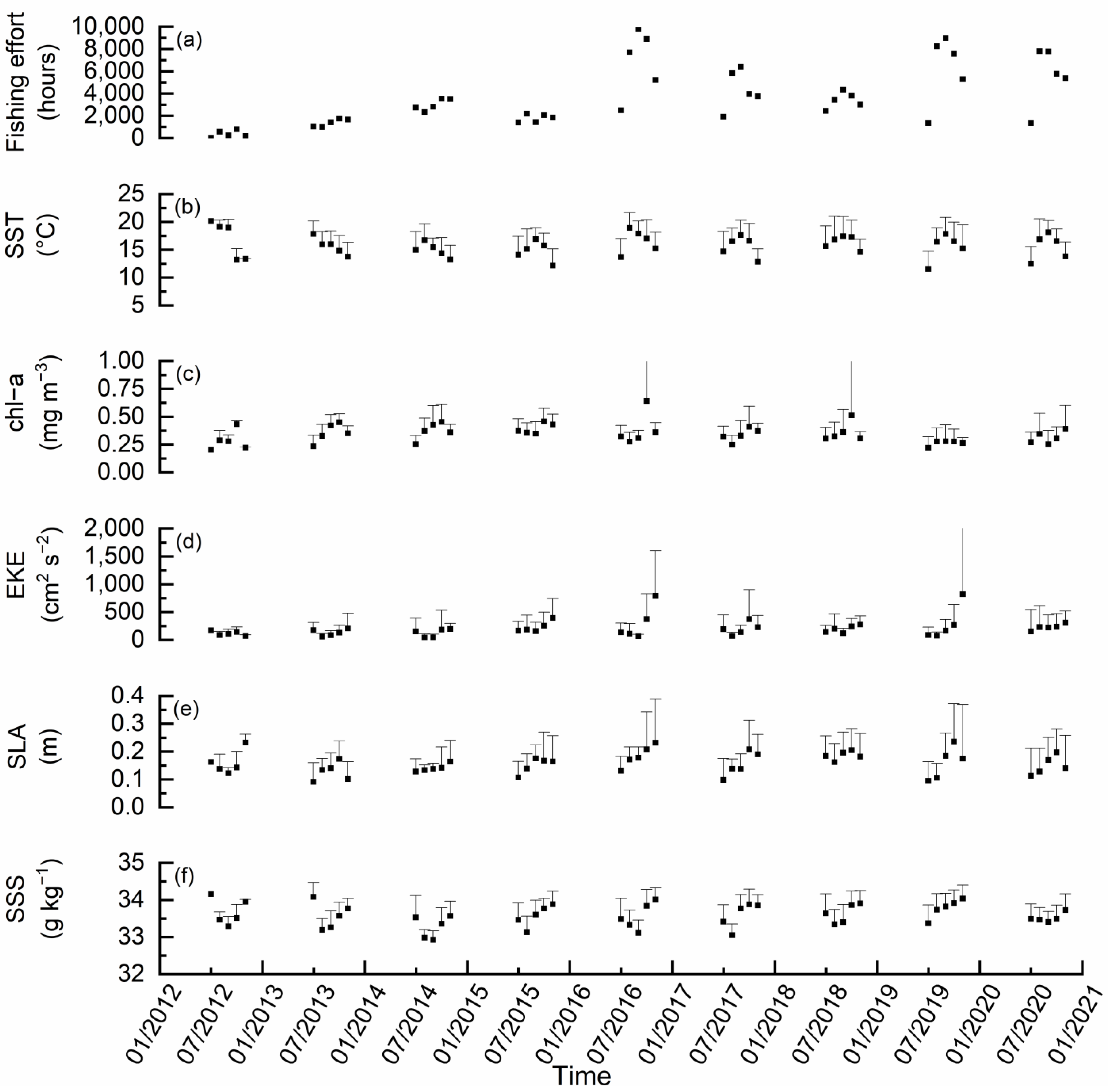
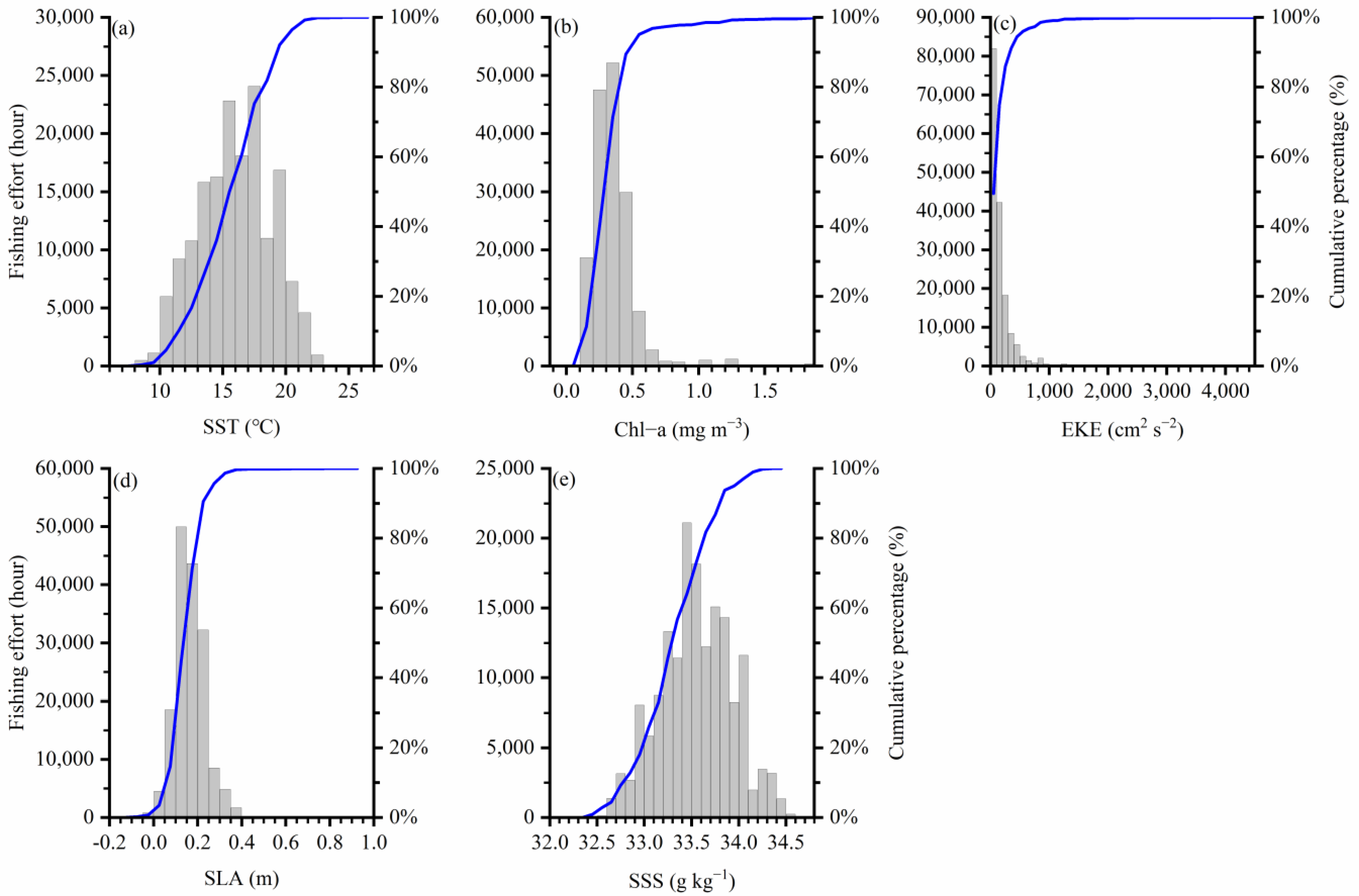
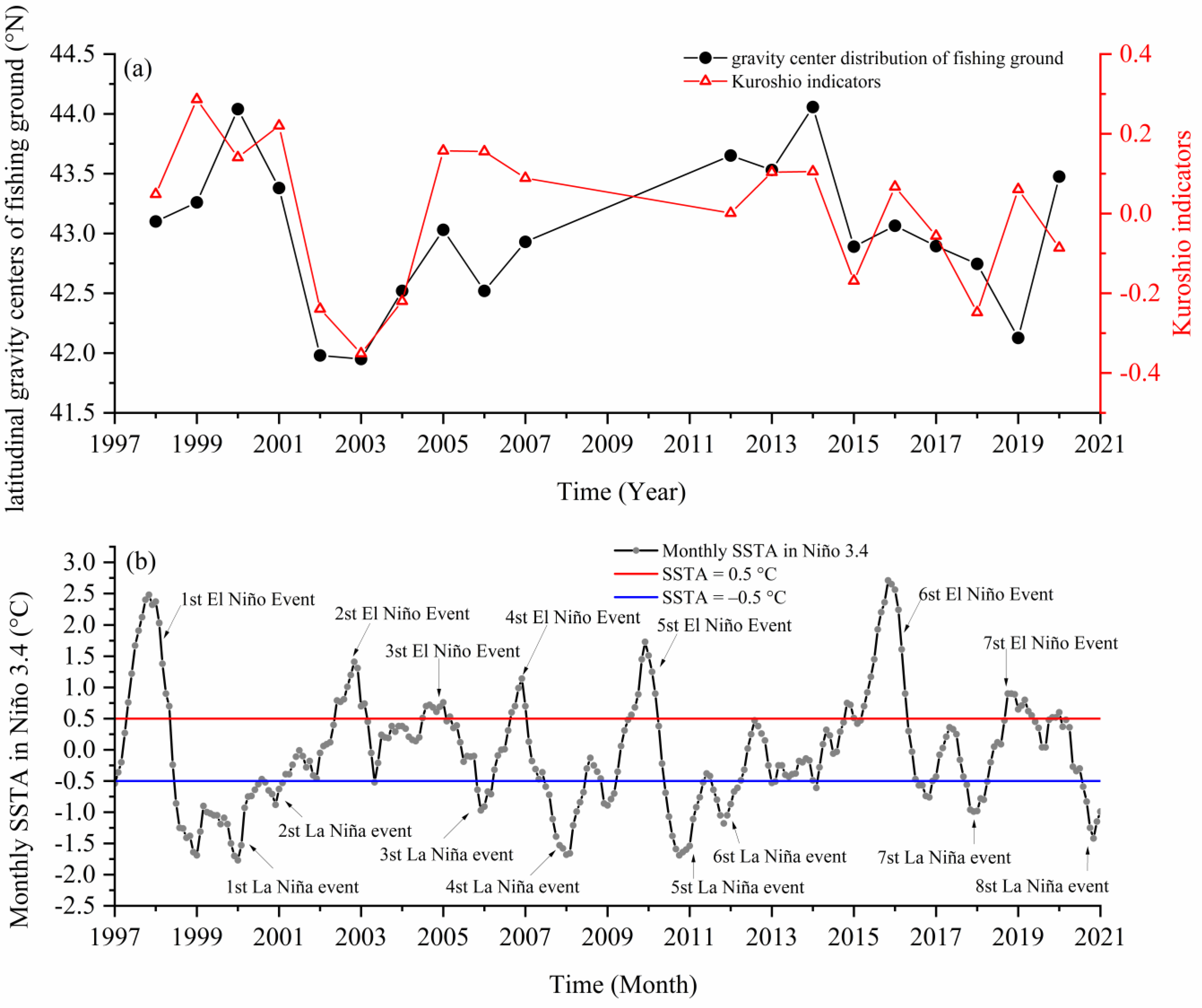
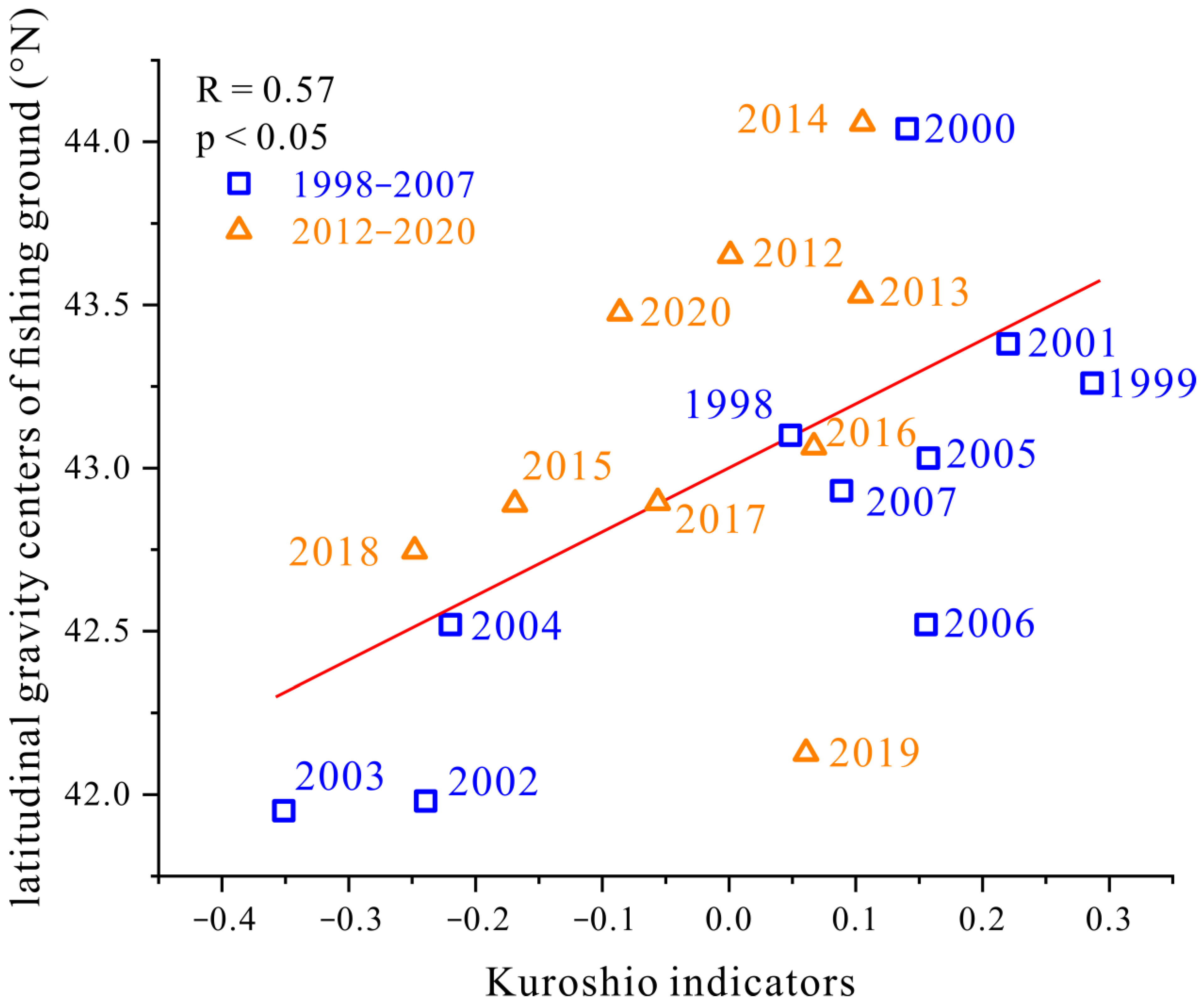
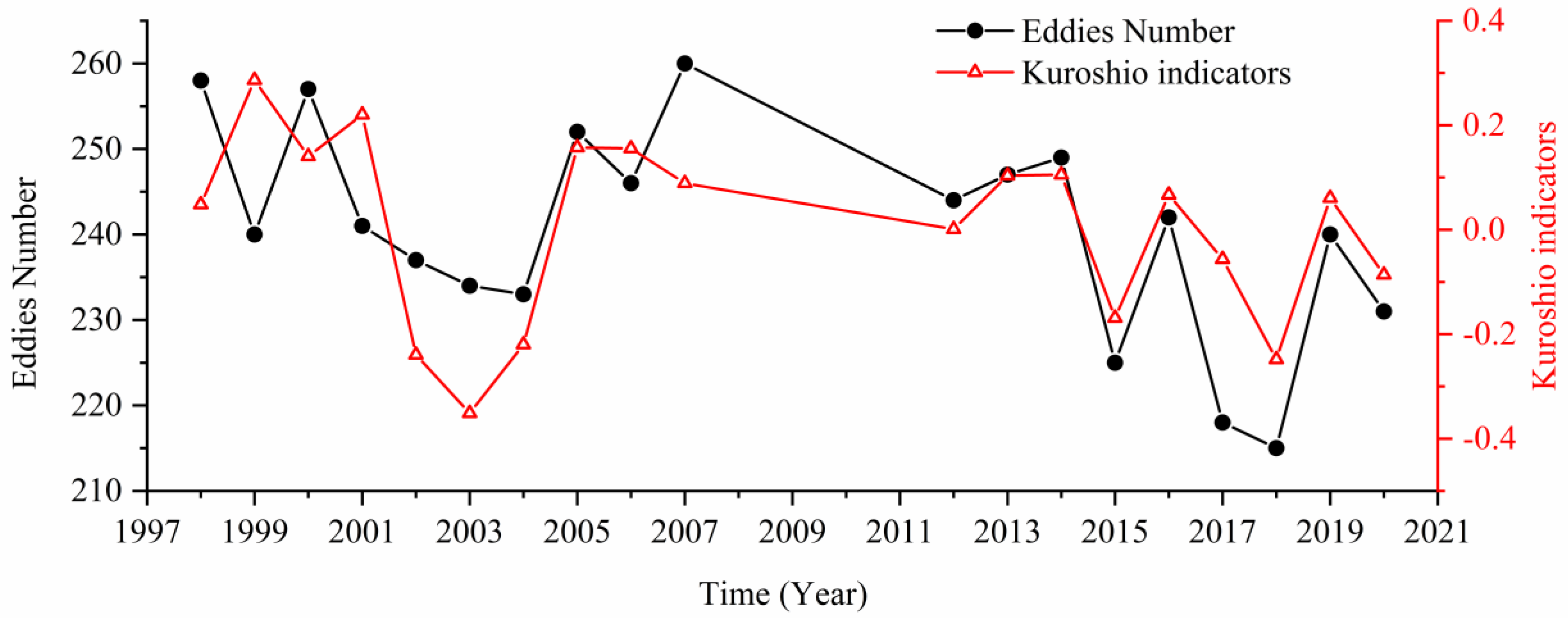
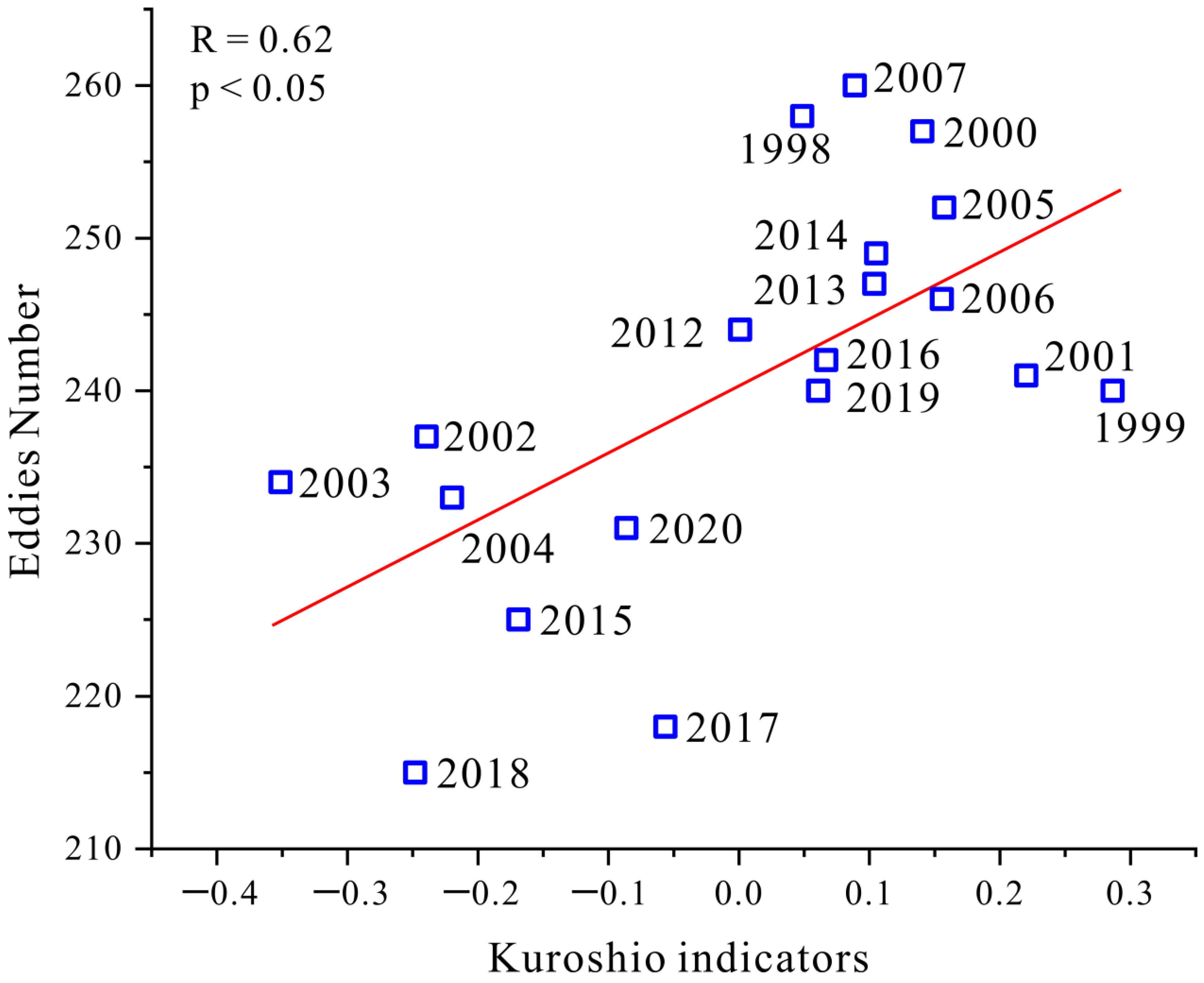
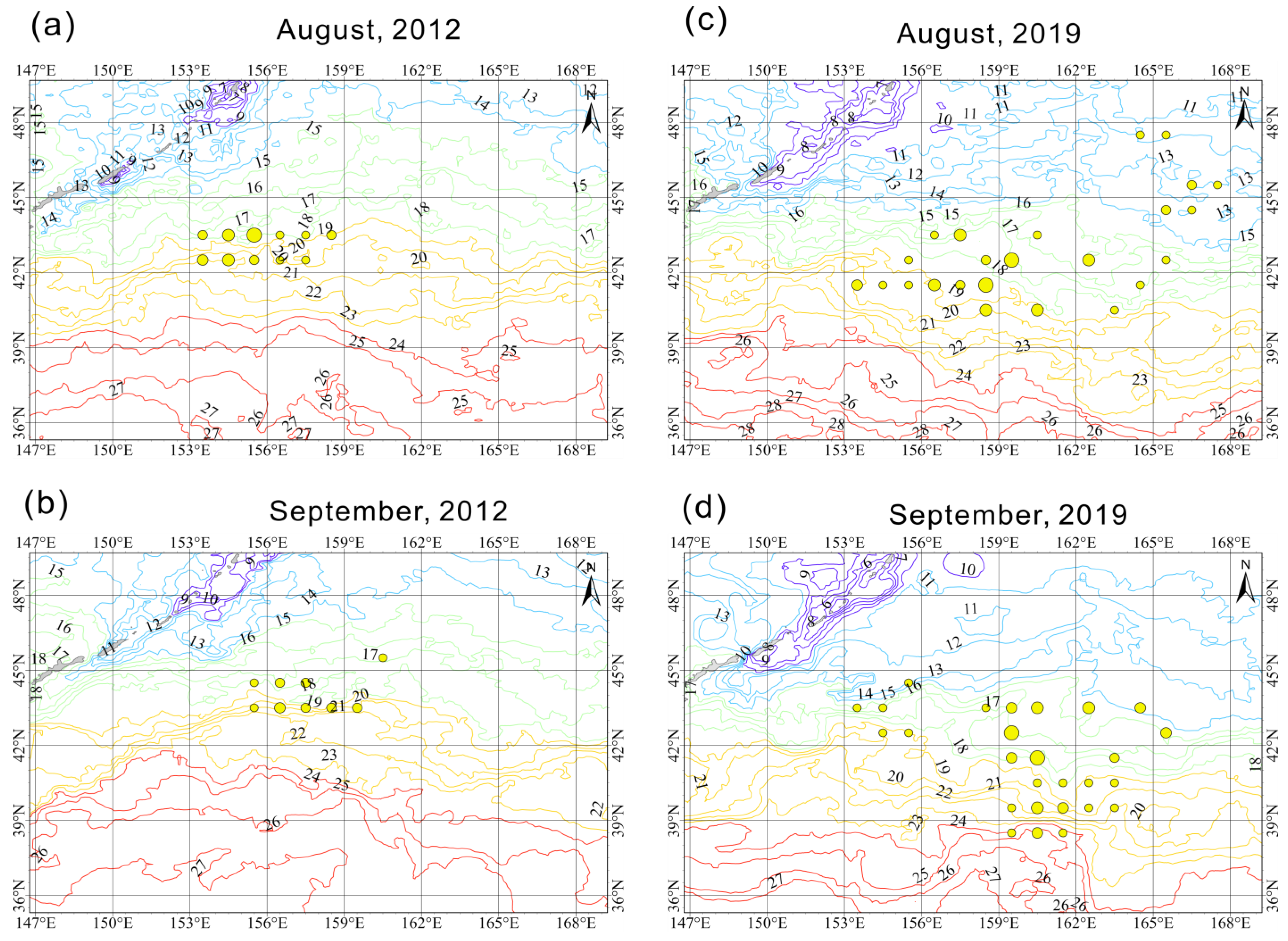
Disclaimer/Publisher’s Note: The statements, opinions and data contained in all publications are solely those of the individual author(s) and contributor(s) and not of MDPI and/or the editor(s). MDPI and/or the editor(s) disclaim responsibility for any injury to people or property resulting from any ideas, methods, instructions or products referred to in the content. |
© 2023 by the authors. Licensee MDPI, Basel, Switzerland. This article is an open access article distributed under the terms and conditions of the Creative Commons Attribution (CC BY) license (https://creativecommons.org/licenses/by/4.0/).
Share and Cite
Li, J.; Cui, X.; Tang, F.; Fan, W.; Han, Z.; Wu, Z. Effects of Kuroshio and Mesoscale Eddy on Fishing Ground Gravity of Neon Flying Squid Ommastrephes bartramii in Northwest Pacific Ocean. J. Mar. Sci. Eng. 2023, 11, 966. https://doi.org/10.3390/jmse11050966
Li J, Cui X, Tang F, Fan W, Han Z, Wu Z. Effects of Kuroshio and Mesoscale Eddy on Fishing Ground Gravity of Neon Flying Squid Ommastrephes bartramii in Northwest Pacific Ocean. Journal of Marine Science and Engineering. 2023; 11(5):966. https://doi.org/10.3390/jmse11050966
Chicago/Turabian StyleLi, Jiasheng, Xuesen Cui, Fenghua Tang, Wei Fan, Zhen Han, and Zuli Wu. 2023. "Effects of Kuroshio and Mesoscale Eddy on Fishing Ground Gravity of Neon Flying Squid Ommastrephes bartramii in Northwest Pacific Ocean" Journal of Marine Science and Engineering 11, no. 5: 966. https://doi.org/10.3390/jmse11050966
APA StyleLi, J., Cui, X., Tang, F., Fan, W., Han, Z., & Wu, Z. (2023). Effects of Kuroshio and Mesoscale Eddy on Fishing Ground Gravity of Neon Flying Squid Ommastrephes bartramii in Northwest Pacific Ocean. Journal of Marine Science and Engineering, 11(5), 966. https://doi.org/10.3390/jmse11050966





